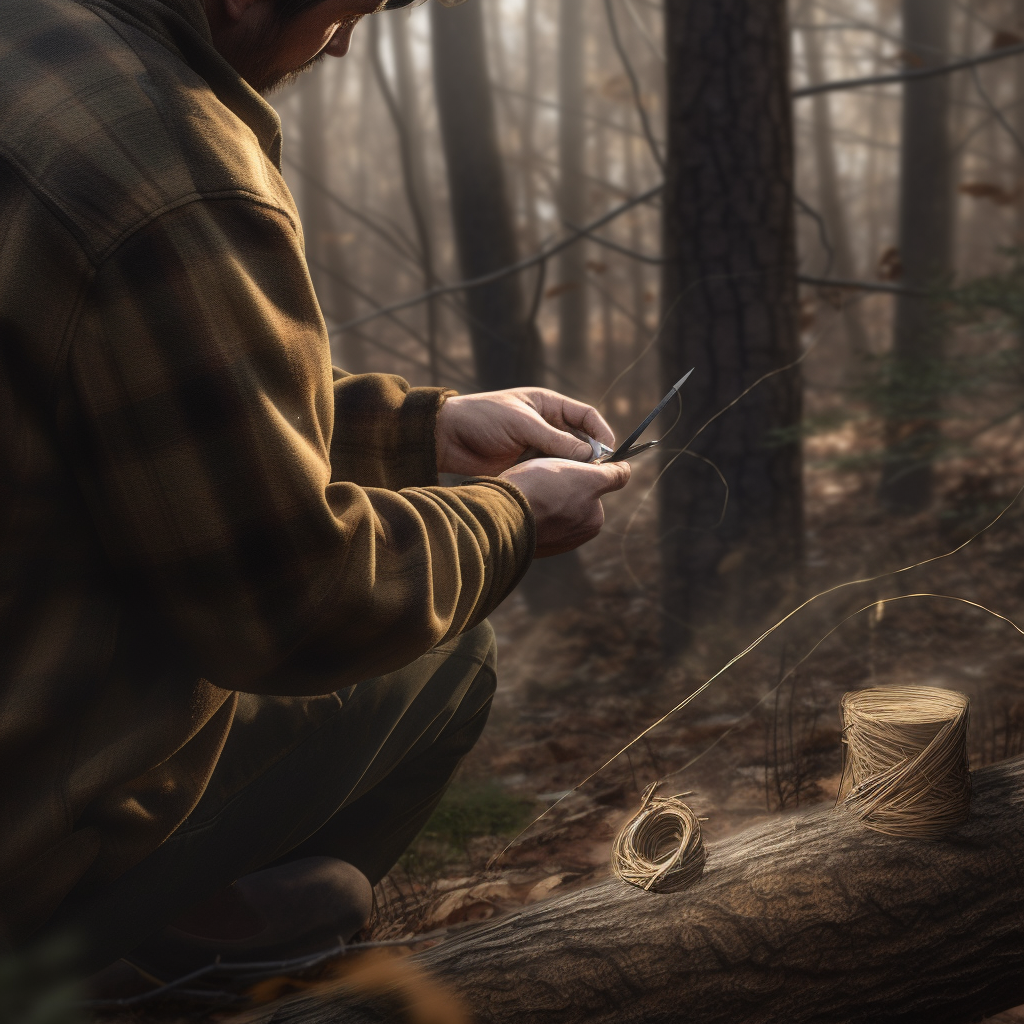When it comes to surviving in the wild, one of the most important skills is knowing how to find and prepare food. Snare traps are one of the most successful and time-tested means of catching small game.
To make a snare trap, find a game trail, then gather a strong, thin cord or snare trap wire. Create a small noose, and attach it to a bent sapling or branch for tension. Secure the trap near an animal’s head height, and camouflage it. Check regularly for captured prey.
Hunters and trappers have used snare traps for centuries to catch animals for food, fur, or protection. These smart devices are simple but work well, and they can be made with few tools and materials. It can capture rabbits, squirrels, and other small wildlife.
In this guide, we’ll explore the art of crafting snare traps. We’ll focus on the practical knowledge, methods, and suggestions to help you become proficient at making and setting them. So continue reading if you want to learn more.
What is a Snare Trap?
A snare trap is a simple yet effective trapping device for capturing animals, primarily for food or pest control. They work by tightening a loop around the animal as it moves through the snare, preventing its escape.
Parts of a Snare Trap

Before teaching you how to build a snare trap, you must be familiar with its different components.
- Snare Loop. Noose-like circle, made of wire or cordage, that tightens around the animal.
- Main Line. The length of wire or cordage that extends from the snare loop to the anchor.
- Anchor Point. A sturdy object, such as a tree or stake, that secures the snare and prevents the animal from escaping.
- Trigger System. A mechanism, typically a notched stick or twig that holds the snare loop in place and releases it when disturbed. It is hooked onto a stake or other piece of wood that is staked to the ground.
- Camouflage. Natural materials, like leaves or branches, used to disguise the trap and blend it into the environment.
Choosing the Right Materials for Your Snare Trap
Some common options for making a snare trap include:
Wire
A snare trap wire is a flexible yet strong wire, made from aircraft cable or steel wire. It’s durable, easy to work with, and holds its shape well.
Rope or Cordage
You can use rope or cordage to create a snare trap in a pinch. Choose a material strong enough to hold the intended animal and withstand exposure to the elements.
Natural Materials
If you don’t have access to wire or rope, you can use natural materials like vines or roots to make a snare trap. Just be aware that these materials may not be as durable or effective as wire or rope.
Selecting the Perfect Location
Location is crucial when setting up a snare trap. Look for areas with signs of animal activity, such as tracks, droppings, or feeding sites.
Setting up your trap along well-used trails or narrow passages where animals are likely to pass through will increase your chances of success.
Step-by-Step Guide on How to Build a Snare Trap
Here’s how to make a basic snare trap in four easy steps:
- Prepare the snare loop: First, create a loop by bending the wire or cordage and twisting the end around the main line. The loop should be large enough to accommodate the intended animal’s head or limb.
- Attach the snare to an anchor: Secure the other end of the wire or cordage to a sturdy anchor, such as a tree or stake in the ground. This anchor will prevent the trapped animal from running off with the snare.
- Create a trigger system: Construct a simple trigger system using a small stick or twig. This can be done by whittling a notch into the stick, where the snare loop will be held in place. When the animal disturbs the trigger, the loop will tighten around it.
- Set the trap: Place the snare loop along the animal’s path at the desired height and position. Ensure the trigger system is set up correctly. Now, gather leaves, branches, or other natural materials to mix in with the surroundings. Arrange these materials around the trap to help it blend in with the environment. Be careful to do it sparingly, as excessive materials may make the trap more noticeable or hinder its function.
H/T to @coalcracker for this video: Securing Food During Survival
How to Make a Snare Trap for Rabbits
To make a rabbit snare trap, follow the steps above. You only need to build a basic snare trap and adjust the loop to approximately 3 to 4 inches in diameter to accommodate a rabbit’s head or limb. Also, position the snare loop about 3 inches above the ground along the rabbit’s path.
How to Setup Different Types of Snare Traps
Ground Snare
A ground snare is the simplest type of snare trap. It is set up directly on the ground, with the snare loop positioned at the height of the target animal’s head or limb. Ground snares work well for smaller animals like rabbits and squirrels.
H/T to @clayhayeshunter for this video: Rabbit Snaring 101
Spring Snare
A spring snare incorporates a bent sapling or branch as a spring mechanism to lift the trapped animal off the ground. This helps to prevent the animal from chewing through the snare or attracting other predators.
To make a spring snare, attach the snare loop to a bent sapling or branch, and set up a trigger system to release the tension when the animal enters the snare.
Keep in mind if using a spring snare, the branch could lose its spring if set for a long period of time or freeze in place during cold weather. This would prevent it from springing up and keeping your catch up off the ground away from other scavengers.
H/T to @SurvivalLilly for this video: How To Build A Spring Snare
Trail-Set Snare
Trail-set snares are designed for use along well-traveled animal trails. They consist of multiple snares set up at intervals along the trail, increasing the likelihood of capturing an animal.
To make these, just follow the steps for making a simple snare trap, and set up several traps along the trail.
H/T to @opencountryhunter for this video: How To Set A Trail Set Snare
Safety Precautions on How to Make a Snare Trap
When working with snare traps, always keep the following safety precautions in mind:
- Be mindful of your surroundings and avoid setting traps near areas frequented by people or pets.
- Use gloves when handling wire or rope to avoid injury.
- Check your traps regularly to minimize the suffering of trapped animals and release any unintended catches.
Legal Considerations
Understanding and complying with local and federal laws regarding trapping is essential. Some jurisdictions may need a license or permit for trapping.
Others may have specific regulations about trap types, locations, and target species. Always check the regulations in your area before setting up snare traps.
Ethical Trapping Practices
To ensure ethical trapping, follow these guidelines:
- Use the target species’ appropriate trap size and type to minimize injury or suffering.
- Check traps frequently to release non-target animals or dispatch trapped animals humanely and promptly.
- Dispose of traps responsibly when they are no longer in use.
Checking and Maintaining Your Traps
Regularly check your traps to ensure they are functioning correctly and have not been tampered with or damaged. Also, when you catch an animal, handle it carefully and humanely. If the animal is not your target, release it as quickly and gently as possible.
FAQs About Survival Snare Traps
How do I choose the right snare size for my target animal?
To choose the right snare size, consider the size of the animal’s head or limb you’re trying to catch. A small loop should suffice for smaller animals like rabbits or squirrels. A larger loop is necessary for larger animals like deer.
Remember that the snare material should also be strong enough to hold the animal securely without breaking.
How often should I check my snare traps?
It’s best to check your snare traps at least once a day to ensure they function correctly and minimize the suffering of trapped animals. In some jurisdictions, there may be legal requirements for how often traps must be checked.
How can I increase the success rate of my snare traps?
To increase the success rate of your snare traps, you can add bait to your traps, choose the right materials and set up your traps in locations with clear signs of animal activity. Camouflage your traps with natural materials. Also, use multiple traps to increase the chances of capturing an animal.
Can snare traps harm the environment?
Snare traps can potentially harm the environment if not used responsibly. To minimize environmental impact, follow ethical trapping practices, such as using appropriate trap sizes, checking traps frequently, and releasing non-target animals promptly.
And when you’re finished using your traps, remove them from the environment and dispose of them properly.
Can I use snare traps for self-defense or home security?
While snare traps are primarily designed for capturing animals, you can use them for self-defense or home security in certain situations.
However, it’s essential to consider the legality and potential hazards of using traps in this manner. More effective and safer methods are available for home security, such as alarm systems or surveillance cameras.
Wrap Up on How to Set a Snare
Knowing how to make a snare trap can be valuable for survival. You can create an effective and efficient trap with the right materials, location, and setup. Follow safety precautions, legal considerations, and ethical trapping practices.
Pro Tip: If using a spring snare, be aware that branches could freeze into place if its cold enough or saplings may lose their spring from being bent into position for a long period of time. This means you need to check your traps often so you don’t lose your catch to other scavengers.
ABOUT THE AUTHOR
Bill Montgomery is the co-founder of Modern Day Prepping. He and his wife Angie have been dedicated to the self-reliant lifestyle since 2008. When he’s not working on the homestead, he enjoys tinkering with electronics and family movie nights with Angie and their two boys. To learn more about Bill, visit the About Us page.
If you want to know how to keep your family safe in the modern world, visit Privacy For Patriots, a sister site that Bill started to help fellow Patriots stay "off the radar" from bad actors and big tech.


0 Comments